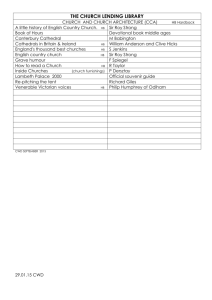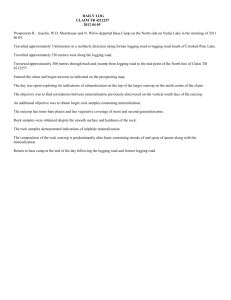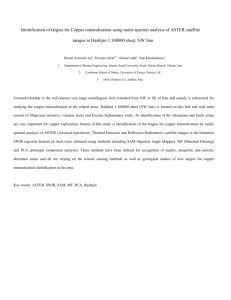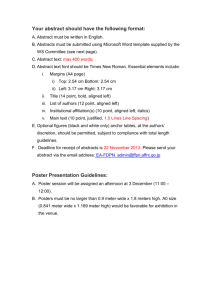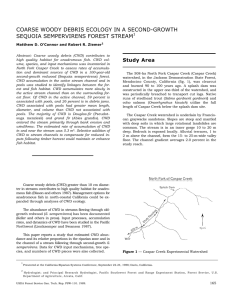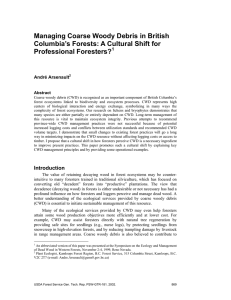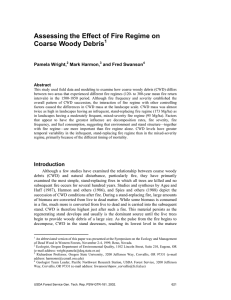1. Know your audience. Choose your journal before you... Know your message. Don’t report irrelevant information. Writing Manuscripts for Publication
advertisement
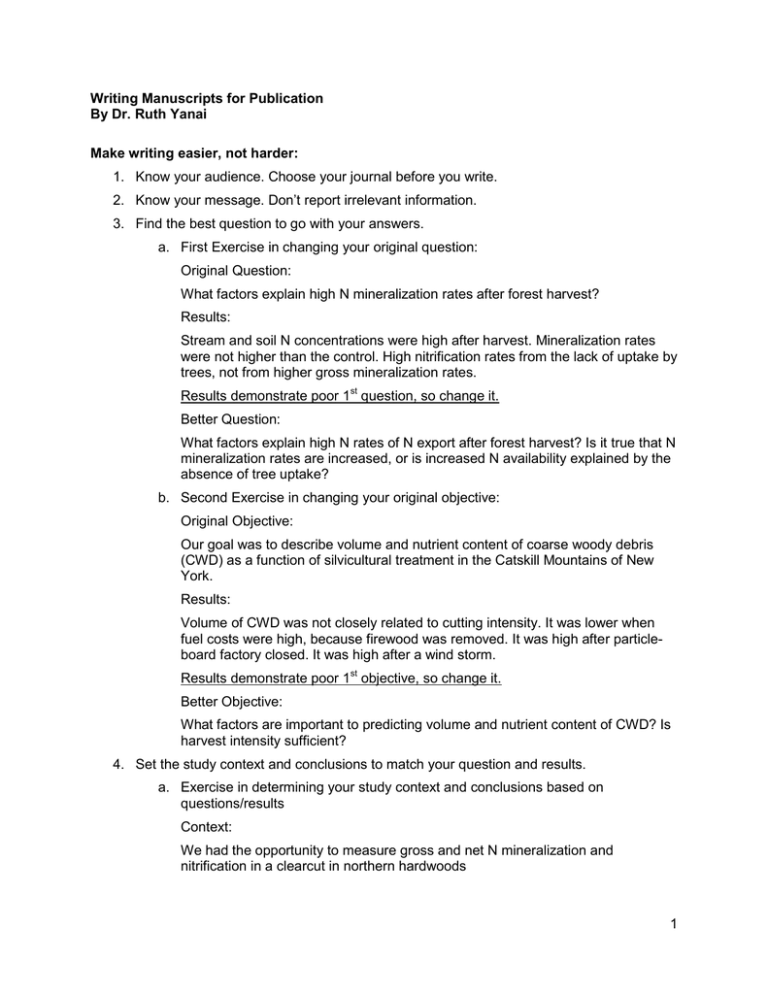
Writing Manuscripts for Publication By Dr. Ruth Yanai Make writing easier, not harder: 1. Know your audience. Choose your journal before you write. 2. Know your message. Don’t report irrelevant information. 3. Find the best question to go with your answers. a. First Exercise in changing your original question: Original Question: What factors explain high N mineralization rates after forest harvest? Results: Stream and soil N concentrations were high after harvest. Mineralization rates were not higher than the control. High nitrification rates from the lack of uptake by trees, not from higher gross mineralization rates. Results demonstrate poor 1st question, so change it. Better Question: What factors explain high N rates of N export after forest harvest? Is it true that N mineralization rates are increased, or is increased N availability explained by the absence of tree uptake? b. Second Exercise in changing your original objective: Original Objective: Our goal was to describe volume and nutrient content of coarse woody debris (CWD) as a function of silvicultural treatment in the Catskill Mountains of New York. Results: Volume of CWD was not closely related to cutting intensity. It was lower when fuel costs were high, because firewood was removed. It was high after particleboard factory closed. It was high after a wind storm. Results demonstrate poor 1st objective, so change it. Better Objective: What factors are important to predicting volume and nutrient content of CWD? Is harvest intensity sufficient? 4. Set the study context and conclusions to match your question and results. a. Exercise in determining your study context and conclusions based on questions/results Context: We had the opportunity to measure gross and net N mineralization and nitrification in a clearcut in northern hardwoods 1 Question: What factors explain high N rates of N export after forest harvest? Is it true that N mineralization rates are increased, or is increased N availability explained by the absence of tree uptake? Results: Stream and soil N concentrations were high after harvest. Mineralization rates were not higher than the control. High nitrification rates from the lack of uptake by trees, not from higher gross mineralization rates. Poor 1st context based on question and results, so change it. Context: The belief that decomposition and nutrient mineralization increase following disturbance pervades calculations of local and global C and nutrient budgets, but this belief is not based on direct observation. Conclusions: It is true that nitrate losses increase after harvesting, but this is not due to increased N mineralization. Poor 1st conclusion, it seems like a result, so change it. Conclusions: Ecosystem N budgets should not assume that mineralization increases after disturbance. Carbon budgets, too, may be in error in decomposition is assumed to increase after forest harvest. b. Exercise in determining your study context and conclusions based on questions/results Context: Pools and nutrient concentrations of CWD have not been described in the Catskill Mountains … Objective: What factors are important to predicting volume and nutrient content of CWD? Is harvest intensity sufficient? Results: Volume of CWD was not closely related to cutting intensity. It was lower when fuel costs were high, because firewood was removed. It was high after particleboard factory closed. It was high after a wind storm. Poor 1st context based on objective and results, so change it. Context: Predicting carbon and nutrient content of CWD over time after forest harvesting is important to managing forests for non-timber values. Therefore, we need to know what factors are important to making those predictions. Conclusions: CWD volume is not readily predicted from harvest intensity. 2 Poor 1st conclusion, it seems like a result, so change it. Conclusions: CWD volume should be measured for accurate assessment. Nutrient contents, on the other hand, can be estimated from measured volumes and published concentrations. 5. Sequence of Section Preparation. a. First is results & question as iteration i. Describe results with reference to hypotheses / questions. ii. Tell reader what they should see in the tables and figures. iii. Don’t repeat information available in the tables and figures. b. Second is methods i. Support data presented in the results. ii. Tell enough to allow another scientist to replicate your study. iii. Don’t give information not needed to understand your results or replicate study. c. Third is introduction i. Describe the general problem to be solved. ii. Review the relevant literature, just enough to orient the reader to the problem. iii. Pose specific questions to be answered in the results and discussion. d. Fourth is discussion i. Interpret your results. ii. Place them in the context of other work. iii. Address limitations to your approach. iv. Suggest future work. v. Draw conclusions. Point out applications. Address your opening questions. e. Fifth is abstract i. Problem to be solved. ii. Objectives or hypotheses. iii. Methods or approach. iv. Results. v. Conclusions. f. Last is title i. Should represent paper’s content. ii. Keywords facilitate retrieval in indices. 3 iii. Make it brief but meaningful. Don’t waste words. Pick the best: 1. The effect of mycorrhizal association on seedling uptake of nitrate vs ammonium 2. The effect of mycorrhizal association on nitrogen uptake of Eucalyptus canadulensis 3. Mycorrhizal association improves nitrate but not ammonium uptake in Eucalyptus canadulensis g. Literature cited i. Follow journal format. ii. Errors cast doubt on the author’s attention to detail in research. iii. Bibliographic software helps prevent errors and saves time. 6. Make an outline. Write only what you need. a. Outline components and guidelines at Purdue Online Writing Lab (OWL) URL. i. Parallelism - Each heading and subheading should preserve parallel structure. If the first heading is a verb, the second heading should be a verb. ii. Coordination - All the information contained in Heading 1 should have the same significance as the information contained in Heading 2. The same goes for the subheadings (which should be less significant than the headings). iii. Subordination - The information in the headings should be more general, while the information in the subheadings should be more specific. iv. Division - Each heading should be divided into 2 or more parts. Technically, there is no limit to the number of subdivisions for your headings; however, if you seem to have a lot, it may be useful to see if some of the parts can be combined. 7. Write your paragraphs. Keep them relevant and organized. 4
